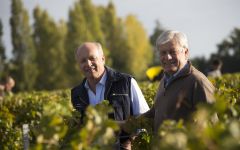Chateau LaTour-Martillac 2004




Product Details
Your Rating
Somm Note
Winemaker Notes
Other Vintages
2019-
Jeb
Dunnuck -
Robert
Parker -
Wine
Enthusiast -
James
Suckling -
Wine
Spectator
-
James
Suckling -
Wine
Enthusiast -
Robert
Parker - Decanter
-
Jeb
Dunnuck -
Wine
Spectator
-
Wine
Enthusiast -
James
Suckling -
Robert
Parker - Decanter
-
James
Suckling -
Robert
Parker -
Wine
Spectator -
Wilfred
Wong
-
Wine
Spectator -
James
Suckling -
Robert
Parker -
Wine
Enthusiast
-
James
Suckling -
Wine
Enthusiast -
Robert
Parker -
Wine
Spectator
-
Wine
Enthusiast -
James
Suckling -
Robert
Parker





Alfred Kressmann, eldest son of Edouard, acquired the property in 1930. He changed the name to avoid confusion with its illustrious namesake in the Medoc and therefore Chateau Latour became Chateau LaTour-Martillac. There then followed a long period of reconstruction. The vineyard consists of a dozen hectares of which the majority was planted in white wine. Without touching the oldest plots, Alfred Kressmann added Cabernet Sauvignon to the merlot already in place. Interrupted by the war, the reconstruction was continued after by Jean Kressmann, who succeeded his father in 1954. Jean finally achieved the family dream to acquire the gravel slope, which separates the property from the village. Thus the vineyard was gradually extended to nearly 30 hectares.
Today, the 6 children of Jean Kressmann own the domain and continue on the family tradition. Tristan and Loïc, the two younger sons, manage the estate with the assistance of the best wine consultants in Bordeaux. With each following vintage they produce the best from this authentic Graves soil. Since the 1980’s, they have increased the area planted in Sauvignon Blanc to compliment perfectly with the Semillon, the historical grape variety of the property. For the red varieties, the tradition of blending Cabernet Sauvignon with Merlot is now topped up with the excellent Petit Verdot variety, which is planted in one of the best gravel plots of the plateau of Martillac.

One of the world’s most classic and popular styles of red wine, Bordeaux-inspired blends have spread from their homeland in France to nearly every corner of the New World. Typically based on either Cabernet Sauvignon or Merlot and supported by Cabernet Franc, Malbec and Petit Verdot, the best of these are densely hued, fragrant, full of fruit and boast a structure that begs for cellar time. Somm Secret—Blends from Bordeaux are generally earthier compared to those from the New World, which tend to be fruit-dominant.

Recognized for its superior reds as well as whites, Pessac-Léognan on the Left Bank claims classified growths for both—making it quite unique in comparison to its neighboring Médoc properties.
Pessac’s Chateau Haut-Brion, the only first growth located outside of the Médoc, is said to have been the first to conceptualize fine red wine in Bordeaux back in the late 1600s. The estate, along with its high-esteemed neighbors, La Mission Haut-Brion, Les Carmes Haut-Brion, Pique-Caillou and Chateau Pape-Clément are today all but enveloped by the city of Bordeaux. The rest of the vineyards of Pessac-Léognan are in clearings of heavily forested area or abutting dense suburbs.
Arid sand and gravel on top of clay and limestone make the area unique and conducive to growing Sémillon and Sauvignon blanc as well as the grapes in the usual Left Bank red recipe: Cabernet Sauvignon, Merlot, Cabernet Franc and miniscule percentages of Petit Verdot and Malbec.
The best reds will show great force and finesse with inky blue and black fruit, mushroom, forest, tobacco, iodine and a smooth and intriguing texture.
Its best whites show complexity, longevity and no lack of exotic twists on citrus, tropical and stone fruit with pronounced floral and spice characteristics.
